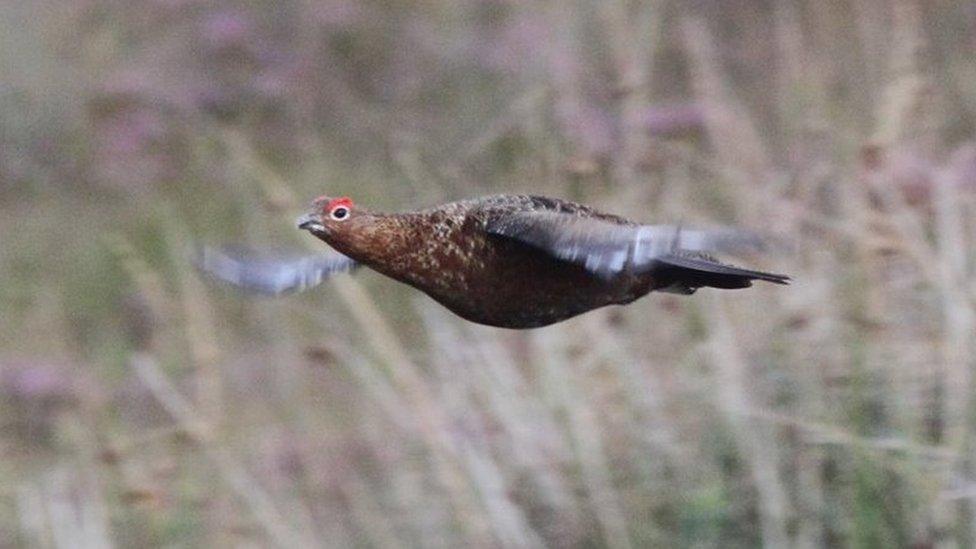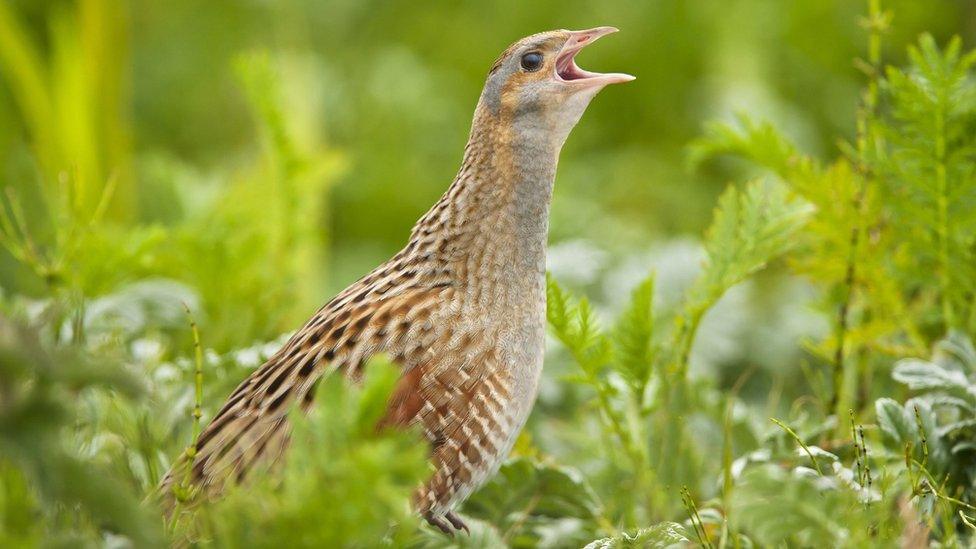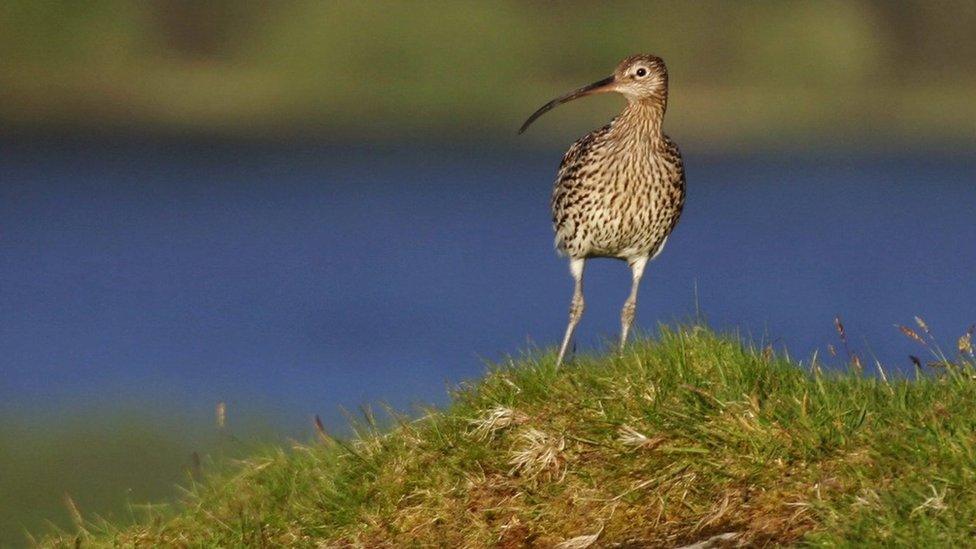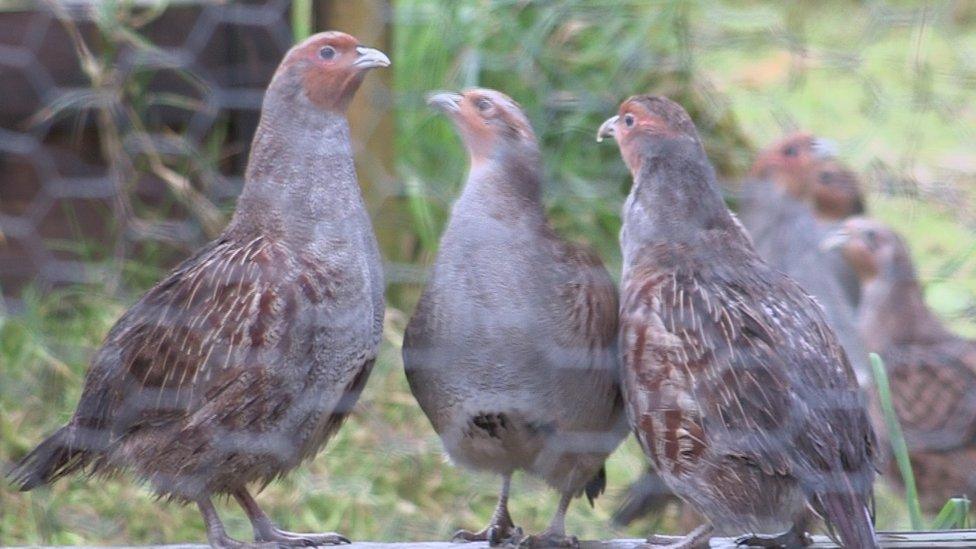Are we ignoring 'second-class' birds for the 'charismatic'?
- Published

The Irish red grouse in flight is a rare sight in Ireland
Wildlife expert Chris Packham once caused a stir by suggesting that conservation efforts should focus on protecting habitats of all wildlife, rather than focusing on "famous" animals.
The BBC presenter asked if efforts to preserve "t-shirt animals" were harming wider conservation efforts.
A recent study suggested many people are unaware that animals they consider as "charismatic" are actually under threat in the wild.
Does the huge media interest in such species as the curlew or the corncrake harm conservation work with other species?
Some campaigners believe so, but others involved in conservation say that resources, including money, given to help well-known animals benefit all wildlife.
Not-so-famous grouse
John Leech, of the Irish Red Grouse Association, is based in south Galway, the site of the bird's largest population in Ireland.

As with other species, the decline of the grouse has been put down to the loss of habitat
He described conservation efforts aimed at the corncrake in particular as a "farce".
"The waste of money was ridiculous. Over-focus on some species… is driven by academia," he said, pointing out that there have not been as many useful studies on the red grouse.

The decline of the Irish grouse
There used to be many more red grouse in Ireland, but numbers dropped in the late 20th century - partly due to the loss and fragmentation of bogland - and consequently the heather on which the birds feed.
There are still red grouse in Glenwherry in County Antrim, but those birds are thought to be of Scottish, rather than Irish, variety.

PhD papers and studies give the media something to report on, feeding the public with a "one-sided, one dimensional" view, said Mr Leech.
But the many reports on the curlew and the corncrake are not saving the birds, he added.

Corncrakes are counted by listening for the call of males
Controlling predators is vital, he argued, as conservation work is useless otherwise.
He argued putting up fencing on the flat lands surrounding the River Shannon to protect corncrakes was "insanity" as there was no parallel control of crows and magpies which eat the corncrakes' chicks.
The red grouse has never been supported financially because it is seen as a game species, added Mr Leech.

Curlew numbers have been in decline across the island of Ireland
He said images of commercial shoots in Britain give people the impression that grouse numbers in Ireland are healthy, even though his own gun club has not shot a grouse since 1983.
Despite the lack of funding, Mr Leech hoped grouse numbers in Ireland could increase.
Funding attracted by hen harrier conservation efforts has indirectly benefited the grouse as the larger bird needs greater numbers of grouse on which to feed.
'Showcase' species
Claire Barnett, a senior conservation officer with the Royal Society for the Protection of Birds (RSPB) in Northern Ireland, believes the curlew's media profile helps other less well-known species.
She said that like the corncrake, the curlew's ability to attract funding is vital to the charity.
"The work that we do for those particular species, kind of like our showcase, popular species, helps lots of other species that are less popular with the public.

You may also be interested in:

"While the curlew is obviously in massive decline, we have done loads of research on it and we know what we can do to help," she said.
That work also benefits other wading birds.
As a breeding bird, the corncrake was thought to be extinct in Northern Ireland, although there are suggestions pairs of birds have returned to breed on Rathlin Island.
"The work that we do for corncrake helps lots of invertebrates and lots of other species which are in trouble, and nature is in big trouble," said Ms Barnett.
The fall of perdix
Kieran Buckley works with the Irish Grey Partridge Conservation Trust, external and is passionate about the species.
"If we lose them, we're sucking the mystery out of life, we lose a part of our natural heritage and thus our national identity," he said.
The grey partridge was once common, but changes in farming and its own tendency to stick up for itself in a fight, saw its numbers dwindle until it was declared extinct in Northern Ireland.
"The leaders of the hunting organisations were not at that time bothered to save the last remaining population of a native game bird.
"To be fair, the main bird conservation organisation in the Republic of Ireland did not, at that time, care either.
"Thankfully that situation has changed dramatically over the past two decades."
Mr Buckley said his focus on the partridge did not take away from the importance of the curlew.
'Conservation fatigue'
"Breeding curlew now have what is rightfully the lion's share of publicity because their situation is extremely serious," he said.
"Indeed, the cry of the curlew in spring is still relatively fresh in the minds of the public - which is where it needs to stay."
However, he pointed out that a high profile is not always good for a struggling species.
If the population of corncrakes in Ireland does not show signs of a significant recovery, the species may fall victim to conservation fatigue.
'No lonesome corncrake's cry'
Dr Anita Donaghy of BirdWatch Ireland, an independent conservation organisation, rejected any suggestion that the increased focus on the curlew and corncrake are down to their supposed celebrity status.
Conservationists focus on them "because they are on the verge of extinction", external, she said.
The legal status of the corncrake derives from its inclusion on Annex 1 of the European Union's Birds Directive, external.
The curlew is not included on Annex 1 because its numbers were healthier when the list was drawn up.
Dr Donaghy said the curlew is a "red-listed species" in the Republic of Ireland., external

Corncrakes are counted by listening for the call of males
"It is in serious danger of becoming extinct as a breeding species in Ireland," she said.
"It is for those reasons that these species have this 'special' status."
- Published21 May 2018

- Published8 May 2018

- Published27 January 2016

- Published1 February 2011